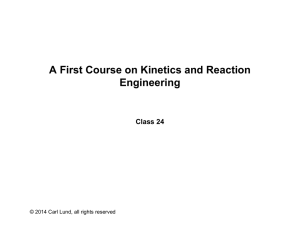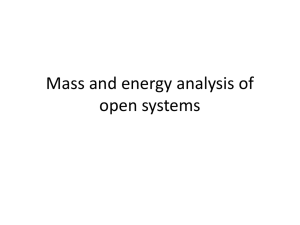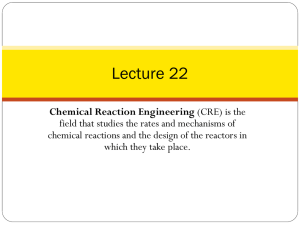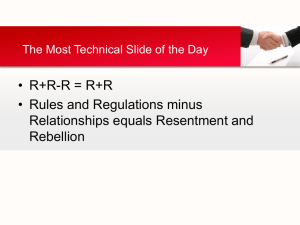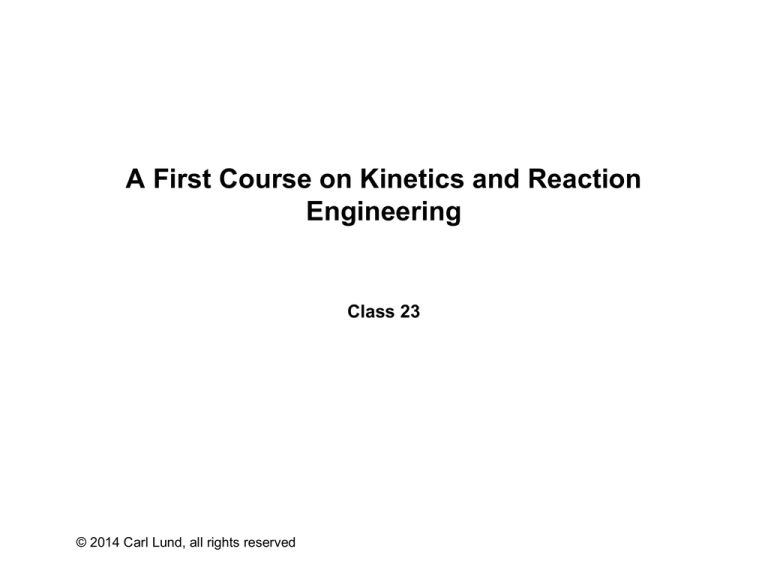
A First Course on Kinetics and Reaction
Engineering
Class 23
© 2014 Carl Lund, all rights reserved
Where We’re Going
• Part I - Chemical Reactions
• Part II - Chemical Reaction Kinetics
• Part III - Chemical Reaction Engineering
‣ A. Ideal Reactors
‣ B. Perfectly Mixed Batch Reactors
‣ C. Continuous Flow Stirred Tank Reactors
-
21. Reaction Engineering of CSTRs
22. Analysis of Steady State CSTRs
23. Analysis of Transient CSTRs
24. Multiple Steady States in CSTRs
‣ D. Plug Flow Reactors
‣ E. Matching Reactors to Reactions
• Part IV - Non-Ideal Reactions and Reactors
Transient Behavior
• While processes may be designed to operate at steady state, occasionally
they still need to be started up or shut down.
‣ Maintenance of equipment
‣ Interruption of feed, heating or cooling
• Definitions
‣ System response: values of the dependent variables (outlet molar flow rates and outlet
temperature) as a function of time
‣ Operating parameters: everything else in the design equations
-
particularly quantities that can change easily (either intentionally or unexpectedly)
• As soon as an operating parameter of a CSTR is changed, the reactor
enters a period of transient behavior
‣ During transient behavior, the outlet molar flow rates and the outlet temperature change over
time
• The transient behavior will end
‣ When (if) the system reaches a new steady state
-
The outlet molar flow rates and temperature approach steady state values over time
The steady state corresponds to the new operating parameters (those in effect after the
most recent change)
‣ When another operating parameter is changed (causing a new period of transient behavior to
begin)
‣ Never; the system could go into a state where the response variables undergo sustained
periodic oscillations
Transient Analysis of CSTRs
• Write a mole balance for every reactant and product of the reactions
taking place
‣
• Write an energy balance on the reaction volume
‣
• If necessary, write an energy balance on the heat transfer fluid, e. g.
‣
• If necessary, add ODEs or eliminate dependent variables so the number
•
of dependent variables and equations are equal
Assuming a numerical solution
‣ Identify the independent variable and its initial value
‣ Identify the dependent variables and their initial values
‣ Write code to evaluate each design equation (ODE) given the values of the independent and
dependent variables
‣ Solve numerically and use the results to complete the requested design or engineering task
Questions?
Activity 23.1
Prior Steady State
Feed Change
Cred = 1
T = 50 ºC
Cred = 1
T = 50 ºC
C
Cred = 0 A
T = 25 ºC
B
• Suppose a stirred tank is operating at steady state as shown on the left
(there’s no reaction), when the inlet composition is suddenly changed
‣ The inlet concentration of red coloring changes from 1 to 0 mol L-1
‣ The temperature of the inlet flow stream changes from 50 ºC to 25 ºC
• Assuming the transient will continue until a new steady state is reached,
•
describe how the concentration of red coloring and the temperature will
vary at the points labeled A, B and C if the fluid is a constant density liquid
Write a transient mole balance on the red coloring
‣ What initial condition is needed to solve this equation?
Qualitative Analysis
Prior Steady State
Feed Change
Cred = 1
T = 50 ºC
C
Cred = 0 A
T = 25 ºC
Cred = 1
T = 50 ºC
B
• At point A
‣ Cred will be constant and equal to 0 mol L-1
‣ T will be constant and equal to 25 ºC
• At point B
‣ Cred will initially equal 1 mol L-1, and it will continually decrease until it becomes equal to 0 mol
L-1
‣ T will will initially equal 50 ºC, and it will continually decrease until it becomes equal to 25 ºC
• At point C
‣ Cred and T will be the same as they are at point B
Mole Balance
Prior Steady State
Feed Change
Cred = 1
T = 50 ºC
Cred = 1
T = 50 ºC
• General mole balance:
C
Cred = 0 A
T = 25 ºC
B
Mole Balance
Prior Steady State
Feed Change
Cred = 1
T = 50 ºC
C
Cred = 0 A
T = 25 ºC
Cred = 1
T = 50 ºC
• General mole balance:
‣ No reaction, so last term equals zero
‣ Constant density fluid and reactor initially full, so V and
-
Their derivatives are then equal to zero
• Mole balance after simplification:
‣ Initial condition is the value of ṅred at t = 0
are constant
B
Activity 23.1
Prior Steady State
Feed Change
Cred = 1
T = 50 ºC
Cred = 1
T = 50 ºC
C
Cred = 0 A
T = 25 ºC
B
• Suppose a stirred tank is operating at steady state as shown on the left,
when the inlet composition is suddenly changed
‣ The inlet concentration of red coloring changes from 1 to 0 mol L-1
‣ The temperature of the inlet flow stream changes from 50 ºC to 25 ºC
• Assuming the transient will continue until a new steady state is reached,
•
describe how the concentration of red coloring and the temperature will
vary at the points labeled A, B and C if the fluid is an ideal gas
Write a transient mole balance on the red coloring
‣ What initial condition is needed to solve this equation?
Qualitative Analysis
Prior Steady State
Feed Change
Cred = 1
T = 50 ºC
C
Cred = 0 A
T = 25 ºC
Cred = 1
T = 50 ºC
B
• At point A
‣ Cred will be constant and equal to 0
‣ T will be constant and equal to 25 ºC
• At point B
‣ Cred will initially equal 1 mol L-1, and it will continually decrease until it becomes equal to 0 mol
L-1
‣ T will will initially equal 50 ºC, and it will continually decrease until it becomes equal to 25 ºC
• At point C
‣ Cred and T will be the same as they are at point B
Transient Mole Balance
Prior Steady State
Feed Change
Cred = 1
T = 50 ºC
C
Cred = 0 A
T = 25 ºC
Cred = 1
T = 50 ºC
B
• General mole balance:
‣ As before
-
no reaction so last term is zero
reaction volume is constant so its derivative is zero
‣ The temperature is changing; pressure and total molar flow rates are constant
-
the volumetric flow rate must also change over time
Two Approaches to Solving
• Express the volumetric flow rate in terms of the other dependent variables
and eliminate its derivative
‣
‣
where f is a known analytic function of the dependent variables (from the
energy balance)
‣ Substituting the known function eliminates the derivative of
page
from the ODE at the top of the
• Add another differential equation
‣
‣ Some ODE solvers (including fsolve in MATLAB) allow the ODEs to be written in matrix form
- M dz = f ( t, z )
dt
‣ Otherwise substitute as above in the original ODE (top of page) and substitute f from above in
the ODE here to get the equations in the desired form for numerical solution
- dz = f ( t, z )
dt
Activity 23.2
• Example 23.1 described a steady state CSTR where the rate of liquid-
•
phase reaction (1) is adequately described by the rate expression given in
equation (2). Reactant A is fed to a steady state CSTR at a rate of 0.01
lbmol min-1, and reactant B is fed at a rate of 0.25 lbmol min-1. This
corresponds to an inlet volumetric flow rate of 0.08 ft3 min-1. The CSTR
has a fluid volume of 18 ft3, and it operates adiabatically. The heat of
reaction may be taken to be constant and equal to -1.7 x 104 BTU lbmol-1.
The heat capacities of A, B and Z are equal to 1000, 180 and 1200 BTU
lbmol-1 °R-1, respectively, and they may be considered to be independent
of temperature. If this reactor was operating at 650 °R and the volumetric
flow rate was suddenly doubled, how would the conversion change?.
A+B⇄Z
(1)
ì -23000 °R ü
r1 = 1.2 ´ 10 ft lbmol min exp í
ý C AC B
T
î
þ
é
ù
ê
ú
CZ
ú
´ ê1ì 20000 °R ü
ê
ú
-13
3
-1
6.5
´
10
ft
lbmol
exp
C
C
í
ý A Bú
ê
T
î
þ
ë
û
(
•
14
(
3
-1
-1
)
)
(2)
Schematic Diagram
1: A + B ⇄ Z;
é
ù
ê
ú
CZ
ì-E ü
ú
r1 = k0 exp í
ý C AC B ê1ì -DH ü
ê
ú
î RT þ
K
exp
C
C
í
ý A Bú
0
ê
RT
î
þ
ë
û
Initial Steady State
=
(constant ρ liquid)
T = 653 ºR
ṅA = 0.0005 lbmol min-1
ṅB = 0.2405 lbmol min-1
ṅZ = 0.0095 lbmol min-1
= 0.08 ft3 min -1
T0 = 650 ºR
ṅA0 = 0.01 lbmol min-1
ṅB0 = 0.25 lbmol min-1
ṅZ0 = 0 lbmol min-1
Change of Operating Parameters
= 0.16 ft3 min -1
T0 = 650 ºR
ṅA0 = 0.02 lbmol min-1
ṅB0 = 0.5 lbmol min-1
ṅZ0 = 0 lbmol min-1
V = 18 ft3
=0
Ẇ≈0
=
T=
ṅA =
ṅB =
ṅZ =
(constant ρ liquid)
Design Equations
Þ
T ( t = 0 ) = 653 ºR
Numerical Solution
T ( t = 0 ) = 653 ºR
• Initial values given above
• Code to evaluate derivatives
é
ù
ê
ú
C
ì -23000 °R ü
Z
ê
ú
r1 = k0 exp í
C
C
´
1ý A B
T
ì 20000 °R ü
ê
ú
î
þ
ý C AC B ú
ê K0 exp í
T
î
þ
ë
û
Solve for many values of t and plot
‣ Only variable quantity in ODEs is r1
•
Results
Where We’re Going
• Part I - Chemical Reactions
• Part II - Chemical Reaction Kinetics
• Part III - Chemical Reaction Engineering
‣ A. Ideal Reactors
‣ B. Perfectly Mixed Batch Reactors
‣ C. Continuous Flow Stirred Tank Reactors
-
21. Reaction Engineering of CSTRs
22. Analysis of Steady State CSTRs
23. Analysis of Transient CSTRs
24. Multiple Steady States in CSTRs
‣ D. Plug Flow Reactors
‣ E. Matching Reactors to Reactions
• Part IV - Non-Ideal Reactions and Reactors


